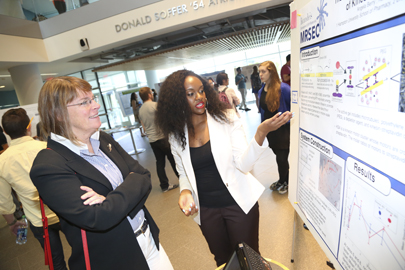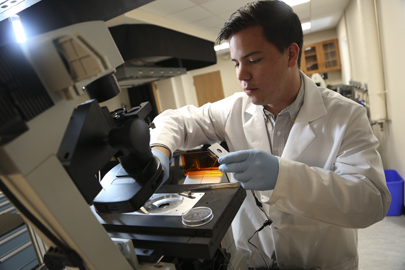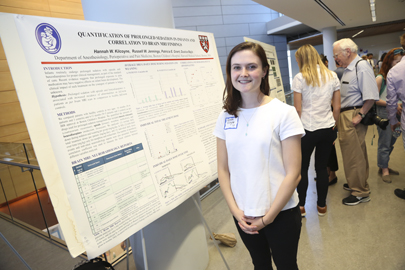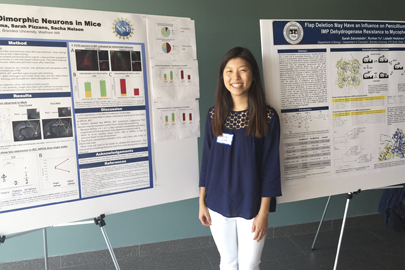SciFest VI: A celebration of undergraduate summer research
Others may head to the beach or go on vacation, but these students spent July in a lab, doing cutting-edge science. Find out what some of them discovered!
SciFest VI, held on August 4, featured presentations by 106 students working with researchers at Brandeis and elsewhere over the summer. Some began three years ago, others in June. A few came from as far away as the Indian Institute of Science in Bangalore, though most attend Brandeis.
This summer was also the first year of an exchange program between Brandeis and Hampton University, a historically African American university in Virginia. Eight Hampton students came to campus to work with Brandeis faculty over the course of ten weeks.
"There is some wonderful science going on here by undergraduates, but it is not undergraduate science," said Dean of Arts and Sciences and professor of neurobiology Susan Birren. "It is science that is critical to moving the fields forward."
Here are descriptions of research by four students at SciFest:
 Angela Berry, sophomore, Hampton University
Angela Berry, sophomore, Hampton University
Faculty Mentor: Zvonimir Dogic, associate professor of physics
Funder: Research Experiences for Undergraduates, Materials Research Science and Engineering Center (MRSEC)
Berry (on right, with Provost Lisa Lynch) studied kinesins, a class of proteins that haul vital cargo from the center to the periphery of cells. She found that a certain type of kinesin moves especially fast along molecular pathways known as microtubules. The long-term goal is to make a gel that can harness the amazing power of kinesins. By taking advantage of natural biological processes, we could create more dynamic, fluid and self-directed materials.

Guillermo Narvaez '18
Faculty Mentor: W. Benjamin Rogers, assistant professor of physics
Funder: SMURF (Summer MRSEC Undergrad Research Fellowship)
Narvaez researched ways that DNA's ability to store information can be harnessed to make new nanomaterials. He attached microscopic bits of plastic to synthesized strands of DNA that contain instructions for building three-dimensional crystals. As the crystals developed, Narvaez altered the temperature to see how it affected the building process. The hope is to one day manipulate temperature and DNA coding so that the DNA — along with the plastic or other material it's carrying— assemble into precisely the right arrangement.
 Hannah Kilcoyne '17
Hannah Kilcoyne '17
Faculty Mentor: Dusica Bajic, assistant professor of anaesthesia, Harvard Medical School
Funder: Boston Children's Hospital
Until the late 1980s, doctors didn't think newborns experienced pain so they didn't give them pain medication for surgery. That's changed, but now the problem is figuring out what health effects these drugs might be having on brain development. Kilcoyne quantified amounts of pain medications given to infants following major surgery. She found that prolonged pain treatment in babies under 12 months old is strongly correlated with an increased incidence of brain abnormalities revealed on MRI scans. Kilcoyne says the results are preliminary, but call for further investigation.
Felicia Lee '18
Faculty Mentor: Sacha Nelson, professor of biology, and research scientist Yasu Shima
Funder: National Science Foundation-funded Research Experiences for Undergraduates (REU) program
Mouse fathers love kids, even ones that are not their own. Virgin male mice, on the other hand, are ruthless baby killers. Why this is so remains something of a mystery. A possible explanation may lie in a group of neurons Lee identified in genetically modified virgin males that are activated during infanticidal behavior. When the virgins mated and became fathers, these neurons didn't activate. This may be one possible reason why they didn't kill their offspring. Lee’s research may ultimately help in understanding human aggression and behavior during fatherhood.
For a full list of funders and poster sessions, click here.
Categories: Research, Science and Technology, Student Life





